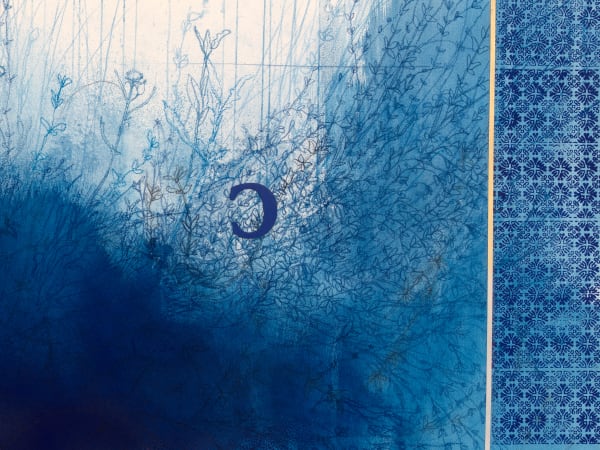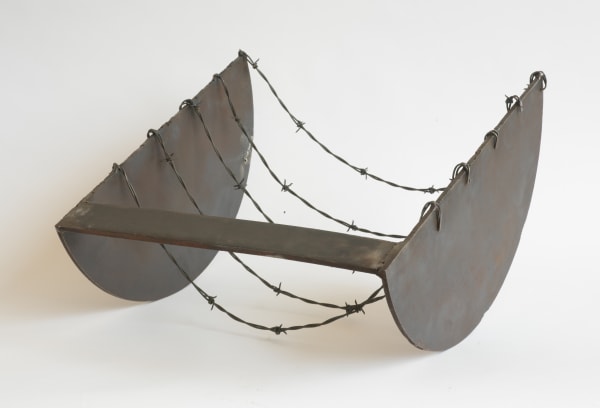Frieze Los Angeles
Santa Monica Airport | Los Angeles | Booth B4 | February 16–19, 2023
Preview (invitation-only): February 16, 2023
Public Days: February 17–19, 2023
Alexander Gray Associates presented new Acoustic Paintings and drawings by Jennie C. Jones, alongside works by Ricardo Brey, Melvin Edwards, Harmony Hammond, Steve Locke, Betty Parsons, Joan Semmel, and Ronny Quevedo. These eight Gallery artists challenge conceptual and formal conventions, each demonstrating innovative approaches to abstraction, materiality, and representation.
Foregrounding the presentation were Jennie C. Jones’s recent paintings, which build on her 2022 one-person exhibition at the Solomon R. Guggenheim Museum and highlight the perception of sound within the visual arts. These paintings incorporate a new material, architectural felt. Like the noise-absorbing foam panels of her earlier compositions, this substrate also has sound dampening properties. Works like Hidden Oxide (2022) and Fluid Red Tone (in the break) (2022) subvert the flat formalism of minimalist painting. Transforming its reductive geometry into something far more expansive and immersive, they physically and aurally extend outwards to actively engage viewers. Similarly, in works on paper like Spontaneous Songs (2022), she illustrates what she refers to as “the gesture of sound,” employing ink and acrylic to contrast bold gesture with the restrained linearity of a collaged musical staff. For Jones, these painterly gestures and compositions across each sheet suggest reverberating sound waves and tonal bursts.
Ricardo Brey integrates disparate historical and cultural legacies into his own practice to speak to his experiences as a Cuban-born artist living and making art in Ghent, Belgium. Shortly after the start of the Covid-19 pandemic, Brey began a series of works on paper that utilize a blue palette—a significant departure from the earth-colored ochers and rusty reds of his earlier drawings. Compositions like Blue loop (2021) submerge rhizomatic botanicals in a sea of blue to evoke the freedom and seemingly limitless expansiveness of the ocean.
Chain is a conceptual language in Melvin Edwards’s sculptures and works on paper that connects the people, cultures, and histories of the African Diaspora. Referencing the multiplicity of meaning found in everyday materials, works belonging to his ongoing series of Lynch Fragments like Fin de siècle (2000) are polyvocal, alluding to both racial oppression and industry. As Edwards explains, “[T]he meaning of the form, or the meaning of the element within a work, is affected by what the context is, what form is next to it, what form is under it or hidden by it.”
A pioneer of feminist and queer discourse, Harmony Hammond’s paintings like Silencia (2016) focus on materiality and the indexical, suggesting topographies of the body. As part of her series of “near monochrome” paintings, this and other recent compositions simultaneously derive from and remain in conversation with her feminist work of the 1970s while challenging the narrative of modernist painting.
As Hammond’s work challenges traditional modes of abstraction, so too does Steve Locke subvert the history of portraiture to explore themes of male desire, vulnerability, and sexuality. Works like cruisers (hotel) (2022) capture intimate moments between gay men. The artist expands, “The exchange of looks, the privilege of looking and the wish to be seen are positions I explore to reveal the ways men respond, desire, and relate to each other.”
Joan Semmel’s practice critically responds to the art historical tradition of the female nude by centering her practice around representations of the body from a female perspective. In Armed (2020), Semmel celebrates color and flesh while highlighting the aging process through the portrayal of her own body. This canvas and other recent paintings situate the female body as a site of autonomy, advocating for a new approach to female representation that challenges the objectification and fetishization of current modes.
Betty Parsons began developing her unique approach to abstraction in the late 1940s in an effort to capture what she dubbed the “sheer energy” and “the new spirit” of life. In Recollection (1972) and Islands (1960–61), she creates compositions inspired by her travels and experiences, transforming the play of light on terrain into geometric forms activated by dynamic brushstrokes and bold colors.
Ronny Quevedo’s material-driven practice explores the complex and intertwined histories of ethnicity, migration, and labor. Works like horizon revision (echoes of the past) (2022) and composite perspective #3 (2021) speak to the artist’s ongoing articulation of the complicated relationships between space, industry, material, and identity. “My visual language incorporates topographies that echo the strategies of pathfinding utilized by migrants,” Quevedo summarizes. “The movement of bodies, like those of constellations, posit geography and space as liminal positions, like players in space.”
Collectively, these eight artists push the formal boundaries of their art-making practices by bridging individual and collective histories to, in Jones’s words, “shape who and what is seen and heard.”
About Frieze:
Frieze Los Angeles is a leading international art fair that was launched in 2019. Christine Messineo is the Director of Frieze Los Angeles and Frieze New York. Frieze Los Angeles largely focuses on contemporary art and celebrates the exceptionally dynamic culture of Los Angeles and its global contributions to the visual arts. For its fourth edition, Frieze Los Angeles will move to the new location of Santa Monica Airport and will take place from February 16-19, 2023.
The new location has been selected for its additional space and flexibility that meet our ambitious plans for the fair, allowing us to welcome innovative art and ideas across all forms of creativity. Positioned in the Southeast corner of the airfield, the fair will take place over multiple sites across the property, with a focus on the signature Frieze bespoke tent, built from the ground up and designed by Kulapat Yantrasast’s WHY studio. The fair will host over 120 of the world’s leading galleries and feature the fair’s much-celebrated section Focus LA, alongside a dedicated edition of Frieze Viewing Room.
Frieze is the world’s leading platform for modern and contemporary art, dedicated to artists, galleries, collectors and art lovers alike. Frieze comprises three publications, frieze magazine, Frieze Masters Magazine and Frieze Week; four international art fairs, Frieze London, Frieze LA, Frieze New York, Frieze Seoul and Frieze Masters; No.9 Cork Street, a permanent gallery space in the heart of London; regular talks and summits, led by frieze editors; and frieze.com - the definitive resource for contemporary art and culture. Frieze is part of the IMG network.









